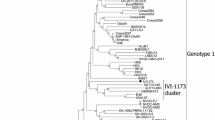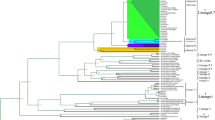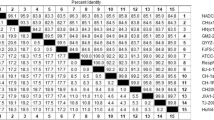Abstract
The nucleocapsid protein of the European genotype of porcine reproductive and respiratory syndrome virus (type 1, PRRSV-1) exhibited extensive size polymorphism (124–130 amino acids), correlating with phylogenetic grouping of ORF7 as well as ORF5 nucleotide sequences, thereby validating ORF7 size as an independent PRRSV-1 subtype marker. Based on new sequence information from the Russian Federation, we propose division of European genotype PRRSV-1 into 3 subtypes: a pan-European subtype 1 and East European subtypes 2 and 3, with nucleocapsid protein sizes of 128, 125 and 124 amino acids, respectively. The genetic differences between European genotype PRRSV subtypes affected diagnostic RT-PCR primer binding sites. Using Escherichia coli-expressed ORF7 protein, we confirmed that even the relatively closely related PRRSV subtypes 2 and 3 were antigenically different. Finally, the isoelectric point (pI) correlated with the nucleocapsid protein size for European genotype PRRSV subtypes, suggesting subtype-specific compensatory structural changes associated with subtype-specific ORF7 sizes. Thus, the new ORF7-based subtype division of PRRSV-1 proposed here is biologically meaningful and practically relevant.





Similar content being viewed by others
References
Balka G, Hornyak A, Balint A, Kiss I, Kecskemeti S, Bakonyi T, Rusvai M (2008) Genetic diversity of porcine reproductive and respiratory syndrome virus strains circulating in Hungarian swine herds. Vet Microbiol 127:128–135
Batista L, Pijoan C, Lwamba H, Johnson CR, Murtaugh MP (2004) Genetic diversity and possible avenues of dissemination of porcine reproductive and respiratory syndrome virus in two geographic regions of Mexico. J Swine Health Prod 12:170–175
Carman S, Sanford SE, Dea S (1995) Assessment of seropositivity to porcine reproductive and respiratory syndrome (PRRS) virus in swine herds in Ontario—1978 to 1982. Can Vet J 36:776–777
Doan DN, Dokland T (2003) Structure of the nucleocapsid protein of porcine reproductive and respiratory syndrome virus. Structure 11:1445–1451
Drew TW (1996) Studies on the genome and proteins of porcine reproductive and respiratory syndrome virus. PhD Thesis, The Open University, London
Fetzer C, Pesch S, Ohlinger VF (2006) High risk of false positive results in a widely used diagnostic test for detection of the porcine reproductive and respiratory syndrome virus (PRRSV). Vet Microbiol 115:21–31
Forsberg R, Oleksiewicz MB, Petersen AM, Hein J, Bøtner A, Storgaard T (2001) A molecular clock dates the common ancestor of European-type porcine reproductive and respiratory syndrome virus at more than 10 years before the emergence of disease. Virology 289:174–179
Forsberg R, Storgaard T, Nielsen HS, Oleksiewicz MB, Cordioli P, Sala G, Hein J, Bøtner A (2002) The genetic diversity of European type PRRSV is similar to that of the North American type but is geographically skewed within Europe. Virology 299:38–47
Forsberg R (2005) Divergence time of porcine reproductive and respiratory syndrome virus subtypes. Mol Biol Evol 22:2131–2134
Gagnon CA, Dea S (1998) Differentiation between porcine reproductive and respiratory syndrome virus isolates by restriction fragment length polymorphism of their ORFs 6 and 7 genes. Can J Vet Res 62:110–116
Groot Bramel-Verheije MH, Rottier PJ, Meulenberg JJ (2000) Expression of a foreign epitope by porcine reproductive and respiratory syndrome virus. Virology 278:380–389
Labarque G, Van Gucht S, Van Reeth K, Nauwynck H, Pensaert M (2003) Respiratory tract protection upon challenge of pigs vaccinated with attenuated porcine reproductive and respiratory syndrome virus vaccines. Vet Microbiol 95:187–197
LeGall A, Legeay O, Bourhy H, Arnauld C, Albina E, Jestin A (1998) Molecular variation in the nucleoprotein gene (ORF7) of the porcine reproductive and respiratory syndrome virus (PRRSV). Virus Res 54:9–21
Mengeling WL, Lager KM, Vorwald AC, Koehler KJ (2003) Strain specificity of the immune response of pigs following vaccination with various strains of porcine reproductive and respiratory syndrome virus. Vet Microbiol 93:13–24
Meulenberg JJM, van Nieuwstadt AP, vanEssenZandbergen A, BosdeRuijter JNA, Langeveld JPM, Meloen RH (1998) Localization and fine mapping of antigenic sites on the nucleocapsid protein N of porcine reproductive and respiratory syndrome virus with monoclonal antibodies. Virology 252:106–114
Oleksiewicz MB, Bøtner A, Toft P, Grubbe T, Nielsen J, Kamstrup S, Storgaard T (2000) Emergence of porcine reproductive and respiratory syndrome virus deletion mutants: correlation with the porcine antibody response to a hypervariable site in the orf 3 structural glycoprotein. Virology 267:135–140
Oleksiewicz MB, Bøtner A, Toft P, Normann P, Storgaard T (2001) Epitope mapping porcine reproductive and respiratory syndrome virus by phage display: the nsp2 fragment of the replicase polyprotein contains a cluster of B-cell epitopes. J Virol 75:3277–3290
Pappu SS, Pappu HR, Lastra R, Niblett CL (1994) Variability in the length of the amino terminal sequence contributes to the capsid protein diversity among dasheen mosaic potyvirus isolates. Arch Virol 136:407–413
Pappu SS, Pappu HR, Rybicki EP, Niblett CL (1994) Unusual amino-terminal sequence repeat characterizes the capsid protein of dasheen mosaic potyvirus. J Gen Virol 75(Pt 1):239–242
Snijder EJ, Brinton MA, Faaberg K, Godeny EK, Gorbalenya AE, MacLachlan NJ, Mengeling WL, Plagemann GW (2005) Family Arteriviridae. In: Fauquet CM, Mayo MA, Maniloff J, Desselberger U, Ball LA (eds) Virus taxonomy: 8th report of the International Committee on Taxonomy of Viruses, Elsevier/Academic Press
Stadejek T, Stankevicius A, Storgaard T, Oleksiewicz MB, Belak S, Drew TW, Pejsak Z (2002) Identification of radically different variants of porcine reproductive and respiratory syndrome virus in Eastern Europe: towards a common ancestor for European and American viruses. J Gen Virol 83:1861–1873
Stadejek T, Oleksiewicz MB, Potapchuk D, Podgorska K (2006) Porcine reproductive and respiratory syndrome virus strains of exceptional diversity in eastern Europe support the definition of new genetic subtypes. J Gen Virol 87:1835–1841
Stadejek T, Oleksiewicz M, Stankevicius A, Potapchuk D, Scherbakov A (2007) Molecular epidemiology of EU-genotype PRRSV in Europe: clues to PRRSV emergence, and implications for disease control. In: 5th international symposium on emerging and re-emerging pig diseases. Krakow, Poland, pp 135–136
Stadejek T, Oleksiewicz MB (2007) Indirect ELISA with recombinant nucleocapsid protein for genotype-specific PRRSV serology: a simple and cost-effective antigen purification scheme. In: 5th international symposium on emerging and re-emerging pig diseases. Krakow, Poland, p 189
Suarez P, Zardoya R, Martin MJ, Prieto C, Dopazo J, Solana A, Castro JM (1996) Phylogenetic relationships of European strains of porcine reproductive and respiratory syndrome virus (PRRSV) inferred from DNA sequences of putative ORF–5 and ORF–7 genes. Virus Res 42:159–165
Truyen U, Wilhelm S, Genzow M, Schagemann G (2006) Porcine reproductive and respiratory syndrome virus (PRRSV): a ring test performed in Germany to assess RT-PCR detection methods. J Vet Med B 53:68–74
van Woensel PA, Liefkens K, Demaret S (1998) European serotype PRRSV vaccine protects against European serotype challenge whereas an American serotype vaccine does not. Adv Exp Med Biol 440:713–718
van Woensel PAM, Liefkens K, Demaret S (1998) Effect on viraemia of an American and a European serotype PRRSV vaccine after challenge with European wild-type strains of the virus. Vet Rec 142:510–512
Author information
Authors and Affiliations
Corresponding author
Additional information
T. Stadejek, M. B. Oleksiewicz and A. V. Scherbakov have contributed equally to this work.
Electronic supplementary material
Rights and permissions
About this article
Cite this article
Stadejek, T., Oleksiewicz, M.B., Scherbakov, A.V. et al. Definition of subtypes in the European genotype of porcine reproductive and respiratory syndrome virus: nucleocapsid characteristics and geographical distribution in Europe. Arch Virol 153, 1479–1488 (2008). https://doi.org/10.1007/s00705-008-0146-2
Received:
Accepted:
Published:
Issue Date:
DOI: https://doi.org/10.1007/s00705-008-0146-2




